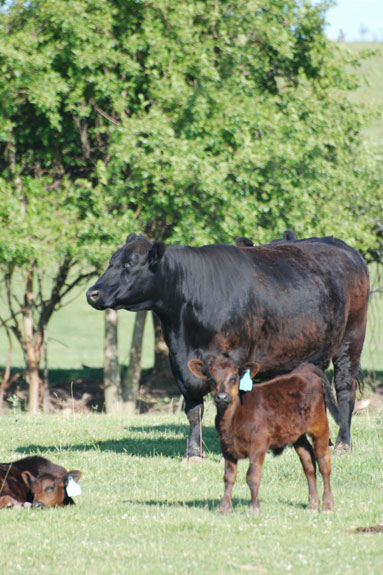Preventing fly discomfort begins by understanding the problem. Steven Myers, consulting beef nutritionist with Land O'Lakes Purina Feed, LLC, explains that both the horn and face fly breed in fresh cow manure and that the horn fly life cycle (from egg to adult) may be as rapid as 10 days in summer temperatures. The life cycle of the face fly is typically three weeks in length.
Though all three fly types are concerning, the small horn fly or Haematobia irritansis shown to cause the most economic damage. Lee Townsend, extension entomologist at the University of Kentucky College of Agriculture, describes horn flies as “small, dark gray flies that feed primarily on cattle.
“Both sexes are blood feeders, taking 20 or more blood meals each day with their stiff, needle-like mouthparts,” he explains. “Irritations from the bites annoy animals and, occasionally, the wounds may become infected.”

Myers finds that cattle bothered by horn flies show discomfort by: shaking their heads, stampeding, bunching in fence corners, wading in water, seeking shade to stand in and generally failing to graze normally. Industry research indicates that obvious signs of discomfort begin when fly populations reach 200 flies per animal.
Cattle discomfort is reciprocated in production losses. Steer and heifer weight gain studies show differences of 10 to 20 pounds per animal per summer when horn flies were controlled on cows. Myers adds that depressed weaning weights on calves, reduced milk production and mastitis spread are indirect effects of horn flies on cows.
Preventative strategies are essential in reducing these production losses. Fly resistance concerns with slow release ear tags and labor intensity of dust bags, oilers, sprays and mechanical traps have made fly control mineral supplements a viable option. When fed with a herd’s mineral program, Insect Growth Regulators follow through the cow’s system and are released in the manure where the product helps to stop the reproduction process of horn, face and heel flies before populations multiply.
“The most practical means of treating manure in grazing cattle is to deliver a fly control additive containing S-methoprene through the cow mineral program,” advises Land O’Lakes Purina Feed, LLC, senior consulting nutritionist N.T. Cosby. “For this approach to be successful, mineral containing S-methoprene must be available to the cows at the start of fly season and provided consistently through frost in the fall.”
For more information on adding a feed-through fly control additive to your nutrition program, contact your beef consulting nutritionist, call 800-227-8941 or click here. ![]()
References omitted but available upon request.
—From Land O’Lakes Purina Feed LLC
PHOTO
Feed-through fly control additives can aid in fly prevention through the summer, helping to promote cow comfort and herd productivity. Photo courtesy of Land O’Lakes Purina Feed LLC.






